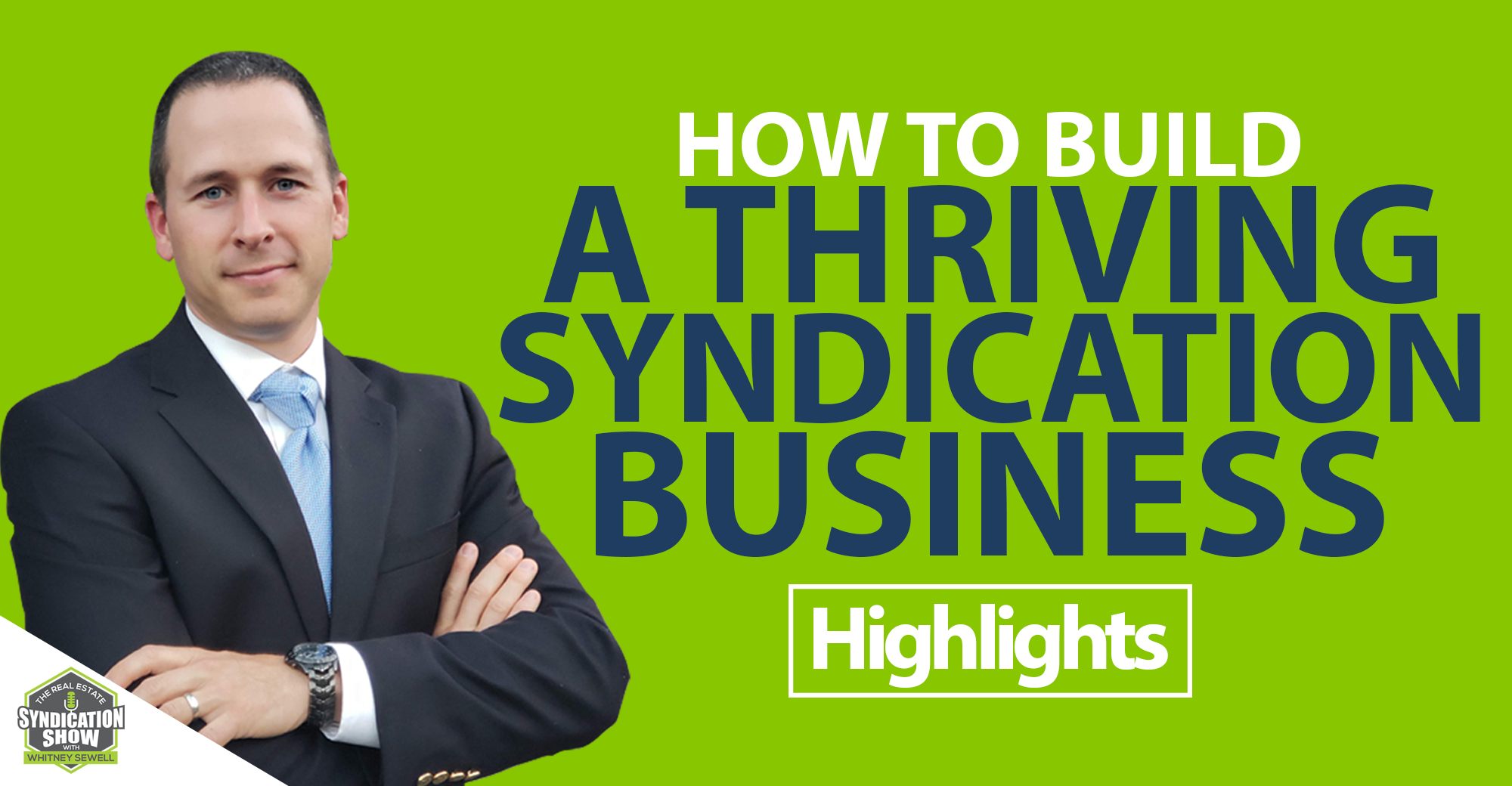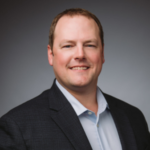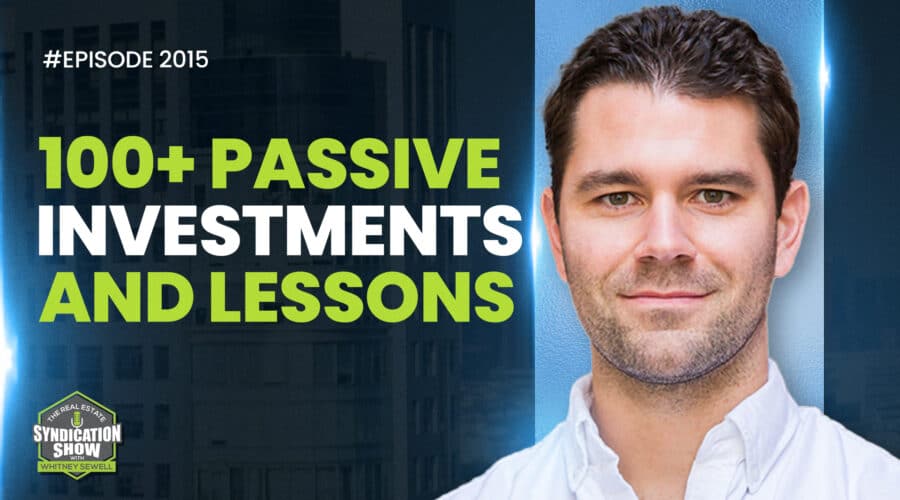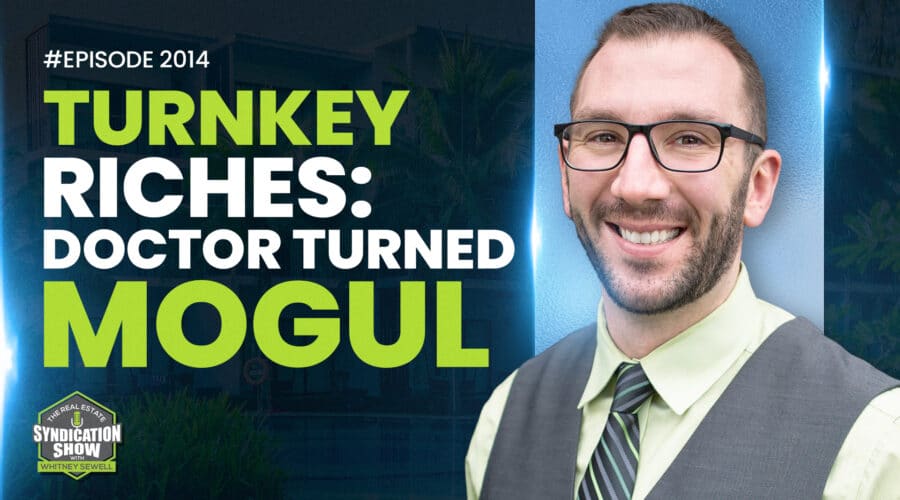If you want to take advantage of high-value real estate with high returns, then diving into multifamily syndication is something you should consider doing now. In this Highlights episode, we feature once again our conversations with Danny Randazzo of Randazzo Capital and Dan Handford of PassiveInvesting.com.
Watch the episode here:
Listen to the podcast here:
Danny discusses how a solid educational foundation and goal-setting helped him find success in real estate syndication. Meanwhile, Dan talks about the three criteria for you to consider when you’re looking at investing passively in syndication. Listen now and find ways how you can thrive in the business!
Key Points From This Episode:
- How did Danny transition to the syndication business? Learn how Danny sold everything he had and moved across the country to get his business going.
- Resources that gave Danny the confidence to venture into multifamily syndication.
- Should you get your wife on board to help you out with your syndication business?
- How did Danny find his first deal?
- Danny shares how he analyzed his first deal
- Dan gives three tips for investing passively in multifamily syndication.
- Some questions that investors should be able to ask a sponsor or syndicator about the leverage or the debt.
- How much is the ideal reserve for multifamily business?
Tweet This!
“We wanted to have a lifestyle that we love. We like to have a lifestyle that we don’t have to need a vacation from. And for us, it heavily revolves around real estate and having multiple streams of income coming in that we can control, still.” — Danny Randazzo
“Real estate, for me, meant kind of the basics: you own an asset, you collect income from it, you need to make sure that the income covers the expenses and covers the debt service, and you should have some left over each month to put into reserves or to put into your pocket, your cash flow.” — Danny Randazzo
“One of the things that you have to look at is when you’re looking at a deal that you’re going to invest passively, where is that leverage component? Where does it land? In most situations, I would say you want to stay around 75% or lower. In certain situations, when you look at them, depending on the asset, it would be okay to go a little bit higher.” — Dan Hanford
“The worst thing you can do in syndication is you can lose a bunch of people’s money, but when you start to do capital calls, that definitely impacts your investors quite a bit.” — Dan Handford
Links Mentioned in Today’s Episode:
Multifamily Investor Nation website
WS232: Earning Passive Income Through Multifamily Syndications with Dan Handford
About Danny Randazzo
Danny and his wife sold everything they owned in the summer of 2016 and relocated to Charleston, South Carolina to build a real estate portfolio. Randazzo Capital made its first investment purchase in the winter of 2016, buying 2 commercial buildings for $1,000,000. Since then, Randazzo Capital has utilized strong investor and lender relationships to purchase another $1,000,000 commercial building, a short sale renovation project, a 4 unit residential rental, a 2 unit residential rental, and 2 beachfront foreclosures. The company controls over $8,000,000 in commercial and residential real estate.
About Dan Handford
Dan and his wife, Dennae, along with their 4 children (3 girls and a boy), reside and work in Columbia, SC.
Dan has an extensive successful background in starting multiple seven-figure businesses from scratch including a large group of non-surgical orthopedic medical clinics located in South Carolina. His family of companies has annual budgets in excess of $10MM.
He is the founder of the Multifamily Investor Nation where he educates a nationwide group (9,000+ members) of multifamily investors on how to properly invest in multifamily assets.
He is the co-host, along with his wife, Dennae, of the Tough Decisions for Entrepreneurs podcast which can be found on iTunes and Google Podcasts.
Full Transcript
EPISODE 1148
[INTRODUCTION]
[0:00:01.6] ANNOUNCER: Welcome to The Real Estate Syndication Show. Whether you are a seasoned investor or building a new real estate business, this is the show for you. Whitney Sewell talks to top experts in the business. Our goal is to help you master real estate syndication.
And now your host, Whitney Sewell.
0:00:24.0
Whitney Sewell (WS): This is your Daily Real Estate Syndication Show. I’m your host, Whitney Sewell. We are introducing a new segment called The Real Estate Syndication Show Highlights, where we’re bringing you a look back at episodes focused on a specific topic that we believe added a lot of value to you in your syndication journey.
Don’t forget to like, share, and subscribe. Also, hit the notification bell so you can continue to know when new shows come out. Have a blessed day!
[INTERVIEW 1]
00:00:49.0
Whitney Sewell (WS): Our guest is Danny Randazzo. Thanks for being on the show, Danny.
00:00:52.0
Danny Randazzo (DR): Hey Whitney, thank you so much for having me on, I’m excited to be here and help the listeners in any way I can.
00:00:58.0
WS: I’m gonna let him give us a little history of how he got into the syndication business. Take it away, Danny.
00:01:03.0
DR: Yeah, Thank you, Whitney. I basically got into the business, I was having conversations with my girlfriend now wife several years ago when we were really talking about what we wanted to get for our lives and how do we wanna live on a daily basis. We were living in the Bay Area out in San Francisco, California, and looking around and seeing how much time we spent commuting, sitting in traffic, and just the mentality of the work-life balance that didn’t quite exist in California, wasn’t as common. Everybody would get together and talk about work or how busy they were at work, and it always made me a little confused as to why some of these people didn’t enjoy what they were doing and just kind of working to work.
And so, that conversation kinda shifted our mindset to where we wanted to build the lifestyle that we love. We like to say a lifestyle that we don’t need a vacation from. And for us, it’s heavily revolved around real estate and having multiple streams of income coming in that we can control. Still, you work harder, you build more income streams, or you strengthen that stream in terms of the volume that it puts out. You can have control over your financial freedom. And for us, that was very exciting, and that meant real estate and having multiple investment properties that generate cash flow, so that’s how we got started. And real estate, for me, meant kind of the basics — you own an asset, you collect income from it, you need to make sure that the income covers the expenses and covers the debt service, and you should have some leftover each month to put into reserves or to put into your pocket, your cash flow.
And so at a very kind of basic elementary level, I knew real estate was a path. It was a pretty proven path that many successful top 500 wealthiest individuals in the world used to either create wealth or protect wealth. And so a proven path is something that I can always get on board with. And my wife was on board. So, we sold everything off in California, moved to Charleston, South Carolina a couple of years ago. And just immediately started buying properties that fit our criteria, and we got started with commercial investments because the numbers worked a little bit better. The cash flow is a little bit higher and the management is a little bit easier compared to having a portfolio of multiple single-family houses, which I think is the traditional way to get started. And from little on, I never really believed in following a traditional path or following the steps to go from A to Z. I always kind of learn step A and figured out how to go to maybe G or R and then to get to Z. So being a little unconventional and just really using basic math of income is greater than expenses and there’s money left to put in your pocket. It seems like a good deal.
0:04:21.8
WS: Well, doing a million dollars in commercial property in the first year is a pretty big accomplishment, seems like to me. Selling everything you have moving across the country, you’re committed, you were committed to making it happen, especially, and doing the two deals.
Tell us a little bit about how you had that confidence to go into a million-dollar commercial property in the first year and not take that traditional path that most people feel like you have to do?
00:04:47.0
DR: It was really about being educated prior to making that first deal. So my life has been built around investing in real estate and buying assets. From early on, I always track my own personal income and expenses and had some financial knowledge to calculate the cost and how much expenses are and things like that. So, I got that level of education and that was able to carry me into being comfortable making that investment purchase. I read books like Rich Dad, Poor Dad. I read commercial real estate investing books by Dolf de Roos. I read and listened to several other books, and then podcast, Bigger Pockets was a good podcast that was out. Joe Fairless’s daily real estate podcast. So I was listening to a bunch of those shows, getting different ideas, thinking about what would work for me and my family. And commercial real estate was the path that we needed to follow to achieve the goals that we set out for ourselves.
And again, the basic math income is greater than expenses and debt service, and then there’s positive cash flow left at the end of the day, that kind of carried me in to say, I’m comfortable making this million-dollar investment decision. It’s unchartered waters. I haven’t made a commercial purchase before, but I’ve bought a home, I’ve rented it, I’m ready to go, I know how it works, and let’s just try and learn as we go.
00:06:23.0
WS: How are you able to get to your wife on board at the time? Was she experienced in real estate at all?
00:06:26.0
DR: No, she really had no background in real estate prior to us moving and kind of selling everything off and going full steam ahead. I got her introduced to some podcasts, and so I think one tip for the listeners is if you and your significant other may have varying opinions of risk or of types of investing methodologies out there, I would say don’t try to educate them from your perspective. Let others do that work. And so, I introduced her to a Bigger Pockets podcast where it was a single female who was an investor and had some similar life experience as my wife did. And she was able to resonate with her message way better than she would resonate with me sitting down and saying, “Let me walk you through cash on cash return analysis and how we factor debt service, and do underwriting.” I would lose her at cash on cash return analysis.
So introduce them to a podcast or an educational forum that they will be receptive to, and at first, my wife to answer the question wasn’t knowledgeable of it, but she believed in me and took the time to educate herself on the value that real estate can bring, and she was able to be extremely supportive very, very quickly.
[INTERVIEW 2]
00:08:04.0
WS: Our guest is Dan Hanford. Thanks for being able to show, Dan.
00:08:06.0
Dan Hanford (DH): Thanks Whitney for having me. I appreciate it.
00:08:07.0
WS: Let’s dive in. I know you have some tips for investing possibly in multifamily syndication, and let’s get started.
00:08:13.0
DH: So I’m gonna probably step on a few toes here Whitney. Okay, obviously, right now everybody is concerned about some sort of downturn in the economy or some sort of correction that might be coming up. And so I come up with these three criteria that when you’re looking at investing passively with another syndication, these are some things that you should look at. And these three emus are primarily with a multifamily syndication. So it’s a different type of syndication, he would probably say that all three of these would still apply. All three of these little things that still apply, whether it be a multifamily or sell storage or whatever commercial. All of these were to apply. So the first what we’re gonna talk about with me is leverage. So for those of you who might not know what that term means is, how much are you getting this or as a loan as concerned to acquire a particular asset. It’s the loan to value ratio or LTV are that loan-to-value. And so that allows you to determine how much are you willing to take on as debt to be able to acquire this asset. And so in most situations, we try to take on as much debt as we can, because the less amount we have to bring to the table, the higher the returns could be. At the same time, you have to balance that with getting over and leveraged or getting too much debt, or you can’t actually pay your debt service if there is a downturn in the economy.
And so one of the things that you have to look at is, is when you’re looking at a deal that you’re gonna invest passively, where is that leverage component, where does it land? In most situations, I would say you wanna stay around 75% or lower. Now, certain situations, we look at them, depending on the asset, would be okay to go a little bit higher, if you have an asset that’s a much larger asset where you know it’s a more stabilized asset, you look back at the historical and see that it’s not really a tip that much, you could maybe stretch it a little bit and go to that 80% leverage. But I’ve seen some deals recently when you have gone to 85%, 86% leverage, and I just not come about that kind of leverage on all these types of assets.
00:10:20.0
WS: And there could be other business plans to it that may change this or maybe the value, the property, or maybe it’s only 50% occupied right now, so the value is really low. But in six months to a year, you’re gonna be revolving, you’re gonna be doing things. And the value is gonna be drastically higher in a year of time.
00:10:35.0
DH: And again, I’m not saying that you should never go over 75, but if you’re looking to invest passively and you wanna stay as conservative as possible, I would say stay below 75, ’cause to me, my comfort level and investing is with preservation of capital. And so we don’t require anything that’s at 50% occupancy because there is no cash flow. As a matter of fact, at 50% occupancy in almost every asset, you’re gonna be putting money into that business, into that situation for the first year to two years until you stabilize.
And so one of the things that we do is we always buy assets that are cash flowing the day we close on them. Now we were not having to worry about that, that 50% not gonna see, Now, somebody who goes in and has that stomach for a 50% occupancy, are they gonna get on a better return if they implement that business plan? I would say yes, but you’re balancing risk versus reward. So there’s a lot of higher risk and take it on a 50% occupancy property versus taking on a 90% occupancy property as well.
00:11:40.0
WS: No, I agree completely. I’ll be 75% of the max usually.
00:11:46.0
DH: Yeah, well, most of the time right now, we’re trying to get it around about 70%, so give or take one or two points, 68, 69, 70, 71 somewhere on in there as far as the leverage is concerned. But we can go up to 75 on some of these assets and of course, some asset classes depend on your lenders, they might not allow you to go past that. Most of the lenders that are not, are gonna allow you to go past that are gonna be the bridge lenders, which are the ones are in a bridge between a permanent agency debt or fix debt, and they’re bridging the gap between you acquiring the property and you be able to get it to a point, or you can go into some of that permanent debt.
And sometimes that bridge is required because you can’t get into an asset and some of this, like in in our situation with Fannie May or Freddie Mac, when you don’t have at least 90% occupancy for at least 90 days, and so you have to start off with a bridge loan first, get the set a stabilized and then go into that. But even though the bridge lender will give you 80% occupants at 80% leverage, you don’t always have to take it.
00:12:45.0
WS: Gave us one or two questions we should be able to ask a sponsor or a syndicator when we’re just concerning the leverage or the debt.
00:12:52.0
DH: Sure, ask him what their plan is. I say, Hey, you know, obviously, hopefully with their presentation, they’ve given you that plan, but unless there’s a reason or a store behind why they’re getting that much leverage, they knew the need to be able to answer that question of “Why are you getting a 86% leverage and are you concern and what are your contingencies in place, what happens in, let’s say, it is a 50% occupancy and see what happens if the day you close, the market turns and you’re in this thing with 86% leverage on a 50% occupancy property?” Are you gonna continue to try to build up and get that stabilize? What’s gonna happen? Are you going to be able to do that?
So a lot of these things are what-ifs and they are speculations, so I don’t like to invest in speculation, and that’s one of the reasons why I like investing in stabilized assets already is that I’m not (inaudible) that I can get it to an increase in occupancy, I’m already at that occupancy level. But you have to ask those questions of “What are your contingencies you have in place if the day we close or six months down the road, after we close, the market turns and work still at 50% occupancy.?”
00:13:56.0
WS: Yeah, what happens?
00:13:58.0
DH: That’s the worst that you can do in a syndication. It is the worst thing. You lose a bunch of people’s money, but you’re trying to do capital calls that definitely impact your investors quite a bit.
00:14:10.0
DH: No doubt. So 75% or lower, and I wanna be able to ask them what their business plan is, they should be able to answer that, and why are you gonna leverage as much? What’s you’re plan if the market turns and what’s next?
00:14:21.0
DH: The second thing that I would want you to look at is the operating reserves because sometimes you look at that and they go, “Oh, we have one month of operating reserves.” And I don’t feel like that’s sufficient. You need to have more than just one month of operating reserves. Three to six, I mean, as much as you can to 12 months of operating reserves. And again, a lot of times, a lot of reasons why syndication groups, they want to have a lot of operating reserves or they don’t put in a lot and in operating reserve because the more money that they put in operating reserves is the more money that they have to raise. The money that they have to raise, it also reduces the returns to the investors as they’re balancing this whole act of they can increase the internal rate return to their investors as well as trying to reduce the amount of money and they have to raise. Because the more they have a raised, the higher the likelihood and they might not be able to raise that amount. And so you wanna make sure that they have not in operating reserves to be able to withhold and withstand a storm that does come, because if you look back in 2008, the market crash, the properties that we’re able to hold on throughout that year, they did very well in the exit of their properties. And then those are the people that have low leverage and had plenty in operating reserves.
00:15:41.0
WS: What are you comfortable with? If I’m a passive investor, what’s that answer that you’re looking for there, if I say, “Okay, you know how much are your operating reserves, so I know that we can weather taht storm?”
00:15:50.0
DH: I think the data has to be an answer that gives you a comfortability level of being able to invest in it. So I store that I like to see is legacy at least three months, sometimes six months. If it’s an asset and it’s kind of like a tertiary city, you might want a little bit more. So it just depends on the asset, depends on the occupancy that it’s currently at, you’re requiring a property that has a little lower occupancy, 80-85%, you might wanna have more in reserves and just in case it draws below that even more. If you have a stabilized a growing economy type in the market that 95% historically for the last several years now, you might not need as much in that operating reserves account. But I would say that the more you can have in that operating reserve the better because it just makes for a lower risk deal. And obviously, the lower the risk below the return, that’s just kind of how it works, but I would rather have a little bit lower return, but how the lower risk so I can I practice that SWAN principle — sleeping well at night. And that’s really the biggest thing is, is that in a syndication model, we’re taking on outside investor’s money, and we wanna make sure that we can sleep well at night, but also our investors to do the same thing.
[END OF INTERVIEW]
00:16:59.0
Whitney Sewell: We hope that you enjoyed the Highlights show today. You can always listen to the full episodes that were featured today by clicking the links on the show notes page. and in the description box. Let us know what you’ve thought of this episode or you can go to lifebridgecapital.com/podcast and click the feedback button. Let us know how we can add more value to you. Thank you and talk to you tomorrow.
[OUTRO]
0:17:24.0 ANNOUNCER: Thank you for listening to the Real Estate Syndication Show, brought to you by Life Bridge Capital. Life Bridge Capital works with investors nationwide to invest in real estate while also donating 50% of its profits to assist parents who are committing to adoption. Life Bridge Capital, making a difference one investor and one child at a time. Connect online at www.LifeBridgeCapital.com for free material and videos to further your success.
[END]
Love the show? Subscribe, rate, review, and share!
Join the Real Estate Syndication Show Community:






